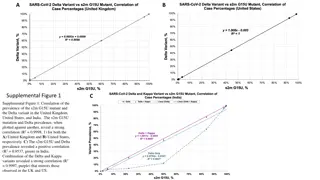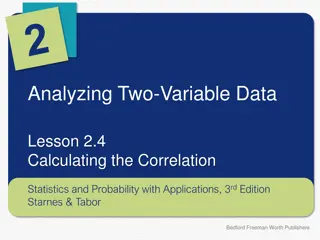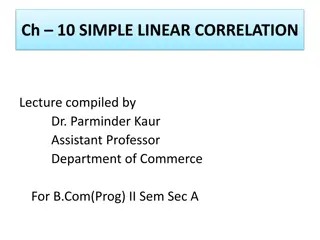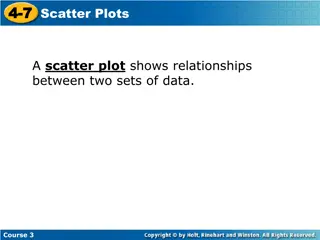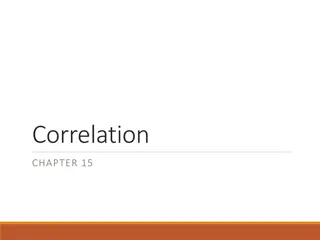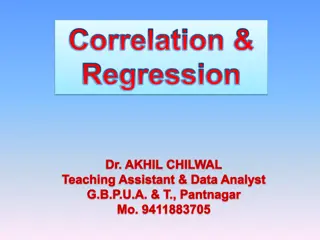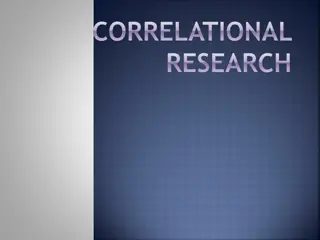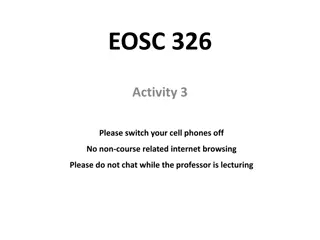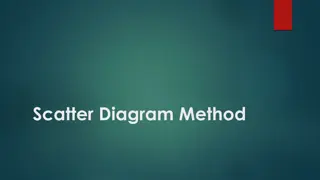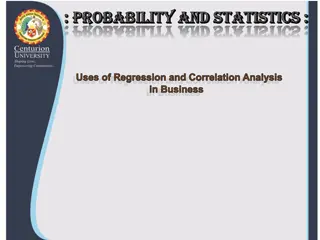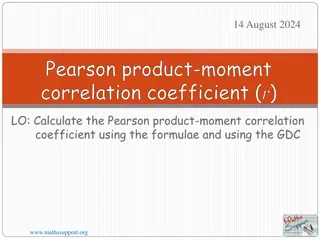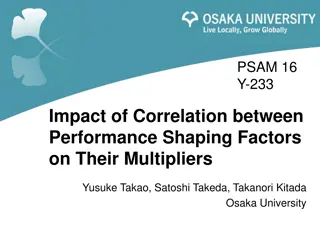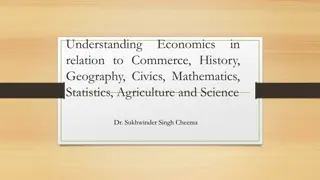Understanding Correlation Analysis in Statistics
Exploring the concept of correlation in statistics: from measuring the strength of linear relationships between variables to interpreting correlation coefficients and coefficients of determination. A practical example involving bass drum sales and TV appearances by a popular group illustrates how correlation analysis can help in forecasting and decision-making.
Download Presentation

Please find below an Image/Link to download the presentation.
The content on the website is provided AS IS for your information and personal use only. It may not be sold, licensed, or shared on other websites without obtaining consent from the author. Download presentation by click this link. If you encounter any issues during the download, it is possible that the publisher has removed the file from their server.
E N D
Presentation Transcript
Chapter 4 Class 4
Correlation How strong is the linear relationship between the variables? Correlation does not necessarily imply causality! Coefficient of correlation, r, measures degree of association Values range from -1 to +1
Correlation Coefficient n xy - x y r = [n x2 - ( x)2][n y2 - ( y)2]
y y x x (a) Perfect positive correlation: r = +1 (b) Positive correlation: 0 < r < 1 y y x x (d) Perfect negative correlation: r = -1 (c) No correlation: r = 0
Correlation Coefficient of Determination, r2, measures the percent of change in y predicted by the change in x Values range from 0 to 1 Easy to interpret For the Nodel Construction example: r = .901 r2 = .81
Problem 4.24 Howard Weiss, owner of a musical instrument distributorship, thinks that demand for bass drums may be related to the number of television appearances by the popular group Stone Temple Pilots during previous month. Weiss has collected the data shown in the following table: Demand for Bass Drums 3 6 7 5 10 7 number of TV appearances 3 4 7 6 8 5 A. Graph these data to see whether a linear equations might describe the relationship between the group's television shows and bass drum sales. B. use the least squares regression method to derive a forecasting equation. C. What is your estimate for bass drum sales if the Stone Temple Pilots Performed on TV nine times last month? D. What are the correlation coefficient (r) and the coefficient of determination (r2) for this model, and what do they mean?
Problem 4.24 (a) Graph of demand The observations obviously do not form a straight line but do tend to cluster about a straight line over the range shown.
Problem 4.24 (b) Least-squares regression:
Problem 4.24 The following figure shows both the data and the resulting equation: ?
Problem 4.24 (c) If there are nine performances by Stone Temple Pilots, the estimated sales are: Y =.676+1.03x Y9=.676+1.03 9=.676+9.27=9.93 drums 10 drums
Problem 4.24 (d) R = .82 is the correlation coefficient, and R2 = .68means 68% of the variation in sales can be explained by TV appearances.
Multiple Regression Analysis If more than one independent variable is to be used in the model, linear regression can be extended to multiple regression to accommodate several independent variables ^ y = a + b1x1 + b2x2 Computationally, this is quite complex and generally done on the computer
Multiple Regression Analysis In the Nodel example, including interest rates in the model gives the new equation: ^ y = 1.80 + .30x1 - 5.0x2 An improved correlation coefficient of r = .96 means this model does a better job of predicting the change in construction sales Sales = 1.80 + .30(6) - 5.0(.12) = 3.00 Sales = $300,000
Problem 4.36 Accountants at the firm Michael Vest, CPAs, believed that several traveling executives were submitting unusually high travel vouchers when they returned from business trips. First, they look a sample of 200 vouchers submitted from the past year. Then they developed the following multiple- regression equation relating expected travel cost to number of days on the road (x1) and distance traveled (x2) in miles: y = $90.00 + $48.50 x1 + $.40 x2 The coefficient of correlation computed was .68 (a) If Wanda Fennell returns from a 300-mile trip that took her out of town for 5 days, what is the expected amount she should claim as expenses? (b) Fennell submitted a reimbursement request for $685. What should the accountant do? (c) Should any other variables be included? Which ones? Why?
Problem 4.36 (a) Number of days on the road X1 = 5 and distance traveled X2 = 300 then: Y = 90 + 48.5 5 + 0.4 300 = 90 + 242.5 + 120 = 452.5 Therefore, the expected cost of the trip is $452.50. (b) The reimbursement request is much higher than predicted by the model. This request should probably be questioned by the accountant.
Problem 4.36 (c) A number of other variables should be included, such as: 1. the type of travel (air or car) 2. conference fees, if any 3. costs of entertaining customers 4. other transportation costs cab, limousine, special tolls, or parking In addition, the correlation coefficient of 0.68 is not exceptionally high. It indicates that the model explains approximately 46% of the overall variation in trip cost. This correlation coefficient would suggest that the model is not a particularly good one.
Monitoring and Controlling Forecasts Tracking Signal Measures how well the forecast is predicting actual values Ratio of running sum of forecast errors (RSFE) to mean absolute deviation (MAD) Good tracking signal has low values If forecasts are continually high or low, the forecast has a bias error
Monitoring and Controlling Forecasts Tracking signal RSFE MAD = (actual demand in period i - forecast demand in period i) ( |actual - forecast|/n) Tracking signal =
Tracking Signal Signal exceeding limit Tracking signal Upper control limit + Acceptable range 0 MADs Lower control limit Time
Tracking Signal Example Cumulative Absolute Forecast Error Qtr Absolute Forecast Error Actual Demand Forecast Demand Error RSFE MAD 1 2 3 4 5 6 90 95 115 100 125 140 100 100 100 110 110 110 -10 -5 +15 -10 +15 +30 -10 -15 10 5 15 10 15 30 10 15 30 40 55 85 10.0 7.5 10.0 10.0 11.0 14.2 0 -10 +5 +35
Tracking Signal Example Cumulative Absolute Forecast Error Tracking Signal Qtr Absolute Forecast Error Actual Demand Forecast Demand (RSFE/MAD) Error RSFE MAD 1 2 3 4 5 6 90 95 115 100 125 140 -10/10 = -1 -15/7.5 = -2 0/10 = 0 -10/10 = -1 +5/11 = +0.5 +35/14.2 = +2.5 100 100 100 110 110 110 -10 -5 +15 -10 +15 +30 -10 -15 10 5 15 10 15 30 10 15 30 40 55 85 10.0 7.5 10.0 10.0 11.0 14.2 0 -10 +5 +35 The variation of the tracking signal between -2.0 and +2.5 is within acceptable limits
Problem 4.45 The following are monthly actual and forecast demand levels for May through December for units of a product manufactured by the N.Tamimi Pharmaceutical Company What is the value of tracking signal as of the end of December?
Problem 4.45 n (At-Ft) t=1 Tracking signal = MAD So: MAD: 87 =10.875 8 39 10.875=3.586


